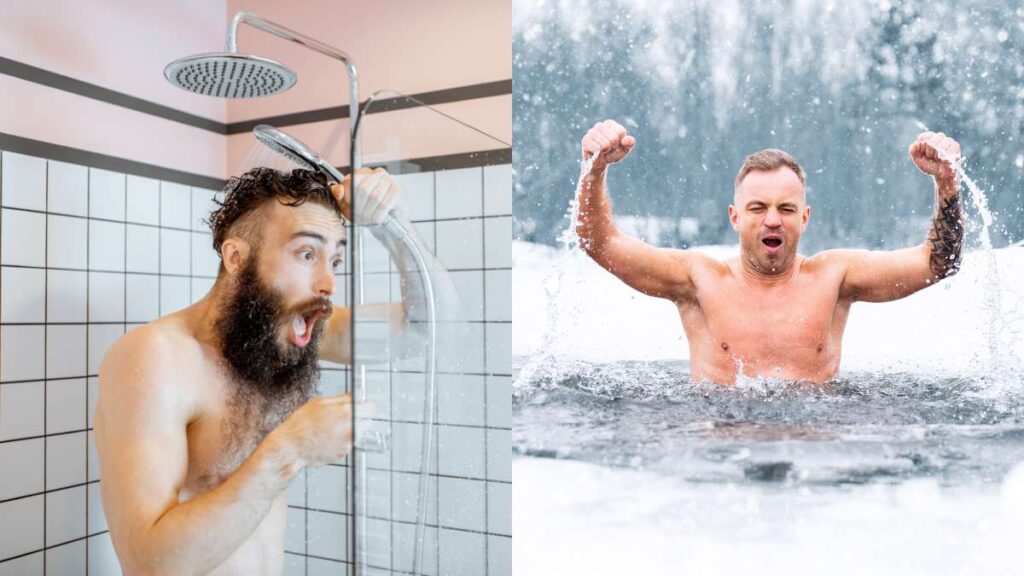Cold Shower vs. Cold Plunge has been a long-standing debate for a while now.
In the pursuit of enhanced recovery, improved circulation, and heightened alertness, individuals often turn to different methods of cold therapy.
Among these approaches, cold showers and cold plunges stand out as popular choices, each offering unique benefits and experiences.
While both involve exposure to cold temperatures, they differ significantly in terms of application, duration, and physiological effects.
Understanding the distinctions between Cold showers and Cold plunges is essential for individuals seeking to incorporate these invigorating practices into their wellness routines effectively.
In this article, we delve into the differences between cold showers and cold plunges, examining their respective impacts on the body and elucidating the factors to consider when choosing between the two.
Cold shower vs. Cold Plunge—which is better?

Cold Shower vs. Cold Plunge?
Cold showers are like a quick, refreshing jolt to your system. The shock of the cold water hitting your skin can feel invigorating, waking you up and leaving you feeling energized for the day ahead.
It’s like a shot of adrenaline, instantly making you feel more alert and alive. People often use cold showers as a way to kickstart their mornings or as a post-workout pick-me-up.
On the other hand, a cold plunge is more like a full-body immersion into icy waters. Imagine stepping into a chilly pool or natural body of water and feeling the cold seep into your bones as you lower yourself in.
It’s a deeper, more intense experience compared to a cold shower, and it requires a bit more mental preparation.
But once you’re in, the sensation is incredibly refreshing, almost like hitting the reset button for your body and mind.
Cold plunges are popular among athletes and wellness enthusiasts for their purported benefits in reducing inflammation, speeding up recovery, and boosting circulation.
How are they different?
One of the main differences between a cold shower and a cold plunge is the level of immersion.
With a cold shower, you’re only exposing certain parts of your body to the cold water, whereas a cold plunge involves immersing your entire body.
Additionally, the duration of exposure tends to be shorter with a cold shower, typically lasting just a few minutes, while a cold plunge may be sustained for several minutes at a time.
How are they Similar?
Despite these differences, both cold showers and cold plunges share some commonalities.
They both involve exposing the body to cold temperatures, which can stimulate the nervous system, increase circulation, and promote a sense of alertness.
Additionally, both practices are believed to have potential benefits for muscle recovery, reducing inflammation, and even improving mood and mental clarity.
What are the Benefit of a Cold shower vs. Cold Plunge?
Cold Showers:

- Morning Wake-Up Call: Imagine the shock of cold water hitting your skin, instantly waking up your senses and sharpening your focus for the day ahead. For many, this icy plunge is the perfect jumpstart to their morning routine, leaving them feeling revitalized and ready to conquer the day.
- Circulation Boost: As the cold water envelops your body, your blood vessels constrict, then rapidly dilate, promoting improved circulation throughout. This surge of blood flow can contribute to overall cardiovascular health, keeping you feeling invigorated and alive.
- Post-Workout Relief: After pushing your body to its limits in a workout, nothing soothes tired muscles quite like a cold shower. The icy water works its magic, reducing inflammation and easing joint soreness, facilitating a speedier recovery process.
- Immunity Booster: A cold shower can also fortify your immune system, making you less susceptible to pesky illnesses like the common cold. Research suggests that exposure to cold temperatures can toughen up your body’s defenses, keeping those sniffles at bay.
- Mood Makeover: Beyond its physical perks, a cold shower can work wonders for your mental well-being. The rush of endorphins released in response to the cold water can uplift your mood, banishing stress and anxiety with each icy droplet.
Cold Plunges:

- Athletic Recovery: For athletes pushing their bodies to the limit, a cold plunge is like a luxurious treat for tired muscles. Submerging yourself in icy waters post-workout helps to quell inflammation and alleviate muscle soreness, facilitating a swifter return to peak performance.
- Inflammation Reduction: Studies show that cold water immersion can dial down inflammation levels in the body, offering relief for conditions like arthritis or persistent pain.
- Circulatory Revival: Similar to cold showers, plunging into chilly waters triggers a cascade of circulatory benefits. Blood vessels constrict, then expand, promoting optimal blood flow and oxygen delivery throughout your entire system.
- Glowing Skin, Glossy Hair: Beyond its internal benefits, a cold plunge can work wonders for your external appearance too. The cold water tightens pores and seals hair cuticles, bestowing you with radiant skin and lustrous locks.
Is it safe to do it every day?
Cold showers and cold plunges can be perfectly safe , but there are important things to consider to ensure your well-being:
- Temperature: IFind the water temperature that’s just right. While chilly water can work wonders, too much of a freeze can be risky, especially if you have particular health issues or sensitivities. Think of it like dipping your toes in before taking the plunge—gradual adjustment is key.
- Duration: Starting with short bursts of cold exposure—whether it’s a quick shower or a brief dip—helps your body ease into the chill without feeling like you’re in the Arctic.
- Health Check: It’s wise to chat with a healthcare professional if you have health concerns. Conditions like heart troubles, breathing issues, or Raynaud’s disease might need a bit of extra consideration before diving into cold therapy.
- Safety First: When it comes to cold plunges, especially in natural waters, safety should be your compass. Make sure you’ve got a buddy or lifeguard nearby, just like when you’re navigating rough waters.
- Warm-Up Afterwards: After braving the chill, give your body a little TLC. Think cozy towels, warm clothes, and maybe even a hot cup of cocoa. Just like you’d warm up by the fire after a snowball fight, gradual warming helps your body get back to its toasty self.
If you have any concerns or medical conditions, consider chatting with a healthcare professional to ensure your cold plunges are nothing short of cool.
Lastly:
Whether you opt for the brisk shock of a cold shower or the immersive chill of a cold plunge, both practices offer a myriad of benefits for your physical and mental well-being.
From increased alertness and energy to improved circulation, faster muscle recovery, and even mood enhancement, the effects of cold therapy are far-reaching.
By incorporating cold showers or cold plunges into your routine, you can invigorate your body, soothe sore muscles, and uplift your mood.
However, it’s crucial to approach these practices mindfully, listening to your body’s signals and consulting with a healthcare professional if needed.
So, whether you’re seeking a refreshing start to your day or a rejuvenating post-workout ritual, consider embracing the icy embrace of cold therapy for a healthier, more vibrant you.


